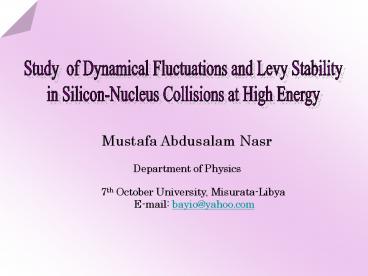Study of Dynamical Fluctuations and Levy Stability - PowerPoint PPT Presentation
Title:
Study of Dynamical Fluctuations and Levy Stability
Description:
... velocities, , produced in Silicon-Emulsion collisions, is used for carrying ... Fig.2 Variation of with for AgBr, CNO and Emulsion group of nuclei ... – PowerPoint PPT presentation
Number of Views:32
Avg rating:3.0/5.0
Title: Study of Dynamical Fluctuations and Levy Stability
1
Study of Dynamical Fluctuations and Levy
Stability in Silicon-Nucleus Collisions at High
Energy
Mustafa Abdusalam Nasr Department of Physics
7th October University,
Misurata-Libya E-mail bayio_at_yahoo.com
2
Out Lines of this Talk
Introduction
Experimental Details
Experimental results
Conclusions
3
Introduction
Systematic and thorough study of
fluctuations in multiparticle production in high
energy hadronic collisions started since the
observation of a relatively high multiplicity
cosmic ray event known as JACEE1 event. In
order to explain the observed fluctuations in the
rapidity distribution for this event, Bialas and
Peschanski proposed2,3scaled factorial
moments(SFMs) approach to investigate dynamical
fluctuations in multiparticle production in high
energy nuclear collisions. The qth order
factorial moment, Fq, is defined as Where M is
the partition number in the available space into
which a given rapidity interval is binned and nm
is the number of particles falling in the mth
bin and the symbol lt .. gt represents vertical
average obtained for the entire event. If the
averaging is done over the whole data sample, the
average value of qth order factorial moment is
calculated from
4
Where denotes the total number of
events in the sample. Many experiments have
reported that exhibit anomalous scaling
behaviour exemplified by Where a small
pseudorapidity interval is partitioned
into M bins each of equal size, .
It is of interest to note that" intermittency" in
particle physics refers to the power-law
behaviour exhibited by with decreasing
bin size. Since the occurrence of fluctuation or
power-law behaviour in relativistic nuclear
collisions has been quite frequently observed, it
therefore suggests that multi-hadronic final
states in these collisions possess self-similar
fractal. Hence one should carry out a study of
Levy stability and multifractal spectrum analysis
for the fractal systems.
5
Experimetal Details
A random sample comprising of 555
interactions having , where
represents the number of charged particles
produced in an event with relative velocities,
, produced in
Silicon-Emulsion collisions, is used for carrying
out the present analysis. The emission angles of
all the relativistic charged particles were
measured and their pseudorapidities were
determined. All other relevant details about the
stacks used, criteria employed for selecting the
events and the method of measuring the emission
angles may be found elsewhere. Furthermore, for
comparing the experimental results with the
corresponding values predicted by the Lund model,
FRITIOF, a sample consisting of 5000 events,
identical to the experimental ones were simulated.
6
Experimental results
Fig.1 Variation of with
It is observed that increases
linearly with for both the data samples.
7
Fig.2 Variation of with
for AgBr, CNO and Emulsion group of nuclei
It is seen that for the three categories of
interactions, CNO, emulsion and AgBr, a linear
rise in the SFMs with decreasing bin width ,
is observed.
8
Fig.3 Variation of Fq with q
- In Fig.3 a linear increase is clearly discernible
in the value of Fq with the order of the moments,
q.
9
Fig.4 Variation of with q
Fig.5 Variation of with q
It is seen from this figure that value of dq is
found to increase with q.
It is interesting to note that exactly similar
trends of variations of with q are observed
for the experimental as well as FRITIOF data
10
Fig.6 Variation of with
It is observed from this figure that the
slope of the best fit to the data defines the
specific heat of the system of multiparticle
final state in relativistic nuclear collisions.
The values of the specific heats for the
experimental and FRITIOF data are found to be
0.6070.017 and 0.8160.206 respectively.
11
Fig.7 Variation of with q
Fig.8 Variation of with q
It is observed from this figure that value of
is found to increase with q.
It is observed from this figure that value of
is found to decrease with the order of the
moments q.
12
Fig.9 Variation of f(a) with a
The plotted against is observed to
have a maximum around 5 for experimental as
well as simulated data.
13
Table 1. calculated values of intermittency
indices , for the interactions of 1
silicon nuclei with CNO and AgBr groups
of targets.
(AgBr) (Em.) (CNO) Order of the moment(q)
2
3
4
5
6
From Table 1 it is clearly evident that amongst
the three groups of targets, the values of
are relatively higher for the collisions due to
CNO targets.
14
Conclusions
Results obtained in the present study
reveal the presence of Intermittency and
multifractality in the data on
silicon-nucleus collisions. Moreover, analyses
for the experimental and simulated data show good
compatibility.
15
Thank you































